Photo ID Sheets with explanation text - boards
-
 by
wreness
moderator
by
wreness
moderator
Here are a collection of photos which will help you identify the things you'll see in the photos on Condor Watch - Carcasses, Condors, Golden Eagles, Coyotes, Turkey Vultures, Ravens. Don't worry if you're still not sure what something is in a photo. Each photo is evaluated several times so do your best as to what you're seeing. Don't stress that you're making a 'mistake' or not marking everything on the form. Our cameras are motion activated so what you see is being photographed the entire time condors are feeding or an animal is within camera range. Because of the data from the Condor Watch Citizen Scientists, this massive project will change the life of the condors, one photo at a time. Thank you for your help!
**For more info See also:
-
- Gallery of Wing Tags - photos of condor wing tag colors, numbers and markings & how they work
-
- Field Guide - for more photos and how to read and mark the Condor wing tags
-
- Colored and Rare Tags - List of all Numbers with photos
Posted
-
-
 by
wreness
moderator
by
wreness
moderator
Carcasses: If you can't see the carcass because there are too many condors here are two tips: Look at the feet of the condors - you can usually spot a glimpse of the carcass between them. Also look at the posture of the condors to see the direction their backs are facing. They will all point inward, like a huddle, with the center being the carcass.
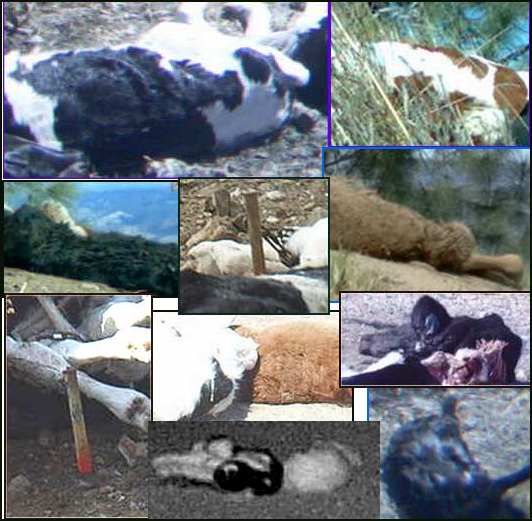
Posted
-
 by
wreness
moderator
by
wreness
moderator
Adult Faces: These are adult condors (with a twist..so hang on!) As condors age their faces turn pink but can have a with a black "mask" or eyebrow near the eyes. They can change the skin color on their faces and neck to reds, purples, yellows, oranges and blues to communicate with each other. They also inflate parts of their faces to communicate, too. All condors have fluffy neck "boas" that they can pull up around their ears if they're cold and down to their shoulders, so necks may or may not be exposed. Juvenile condors have black faces (see condor in center of the 3, bottom photo). You will see condors that are a mix of black and pink - these are teenagers on their way to Adulthood! (bottom). For the sake of classification here, please only mark all - pink adults as "adult. If you're unsure, leave that section blank. .
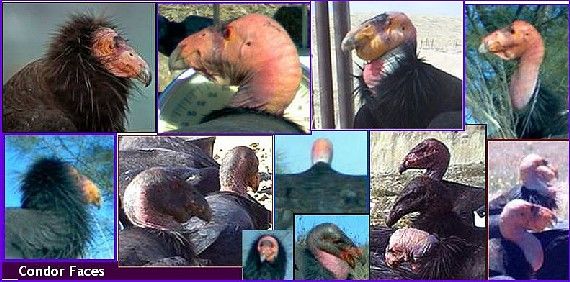
Posted
-
 by
wreness
moderator
by
wreness
moderator
Juvenile Faces: Why So Serious? These are the kids of the group. They have sleek faces. It takes 4-5 years for a condor to turn gradually pink and get its adult colors and puffier look. The pink adult is on the left, top, for comparison.
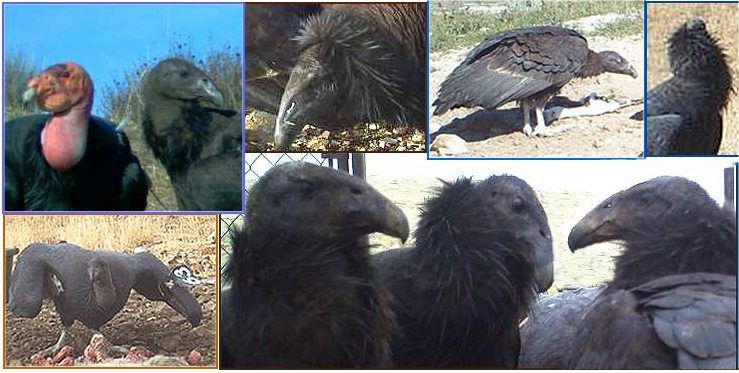
Posted
-
 by
wreness
moderator
by
wreness
moderator
Condor Feet: Sometimes it's difficult to tell if you're looking at a turkey vulture or a condor, or all you'll see are a pile of condors with no idea how to count so many. A good tip is to look at the feet. Condors have 3 toes that point forward and nails that aren't sharp. Since they're not predators they don't tear their food. The legs are thick, huge and white. The feathers reach down to their knees.
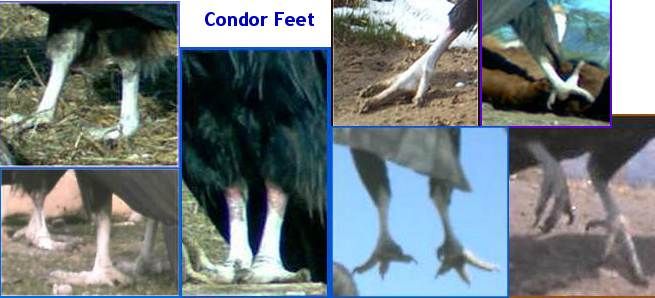
Posted
-
 by
wreness
moderator
by
wreness
moderator
Condor Positions: Condors are black or very dark grey with white side feathers and white feathers under their wings. The juveniles can look very smooth, almost like a duck, at certain angles. When eating they may sit back on their ankles. When full or resting they might go off and become what we lovingly call "Floof muffins" (top right), laying down spreading out, almost looking like a rock or a meatloaf. They are the biggest thing you'll see out there (their wing span is 10 ft. or just over 3 m) so if it's big, it's a condor!
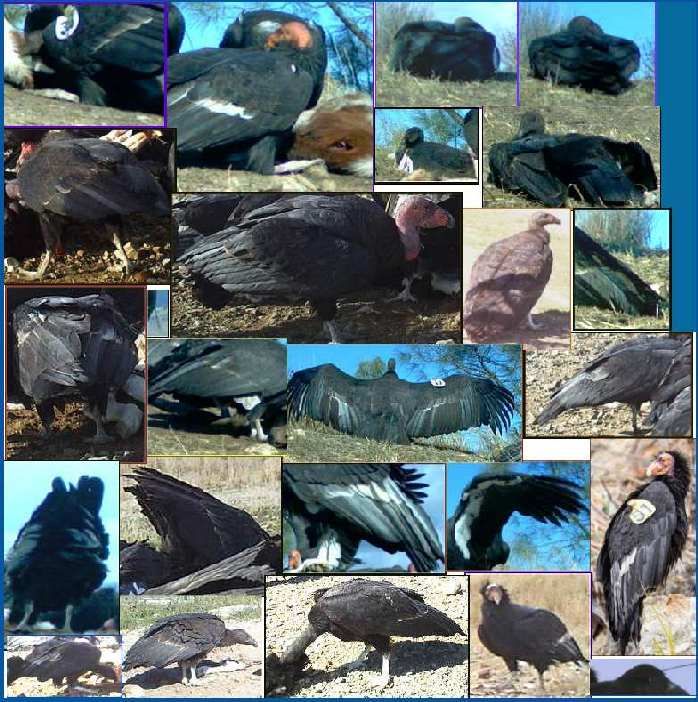
Posted
-
 by
wreness
moderator
by
wreness
moderator
Golden Eagles: Also referred to here as just "eagles", these are vicious predators and will kill condors, coyotes and anyone else. You'll sometimes spot them in photos because the other animals are giving them a carcass all their own or running away screaming like little girls. They get their "Golden" name due to the adult's color but the younger birds can be dark brown. They can be spotted by their very yellow feet, intense yellow eyes, hooked beak, razor sharp talons and infamous "feather pants" that cover the legs down to the feet. They have a very clean profile and stand high off the ground - their backs straight, tail and head usually pointed down at an angle.

Posted
-
 by
wreness
moderator
by
wreness
moderator
Turkey Vulture: Yes, they're funny looking! The have vibrant red heads and ivory-white beaks, so aren't hard to miss. They look a bit like condors because they, too, have a neck feather "boa", but it stays in place and is made of smooth collar of feathers which makes them look stiff and uncomfortable. Their heads stick out like a walking cane handle. Their legs are white-pink; feathers are brown with tan accents. They're low to the ground, and long. They aren't terribly common in the photos here but are regular visitors at certain feeding sites. It's common to see several at the same time.
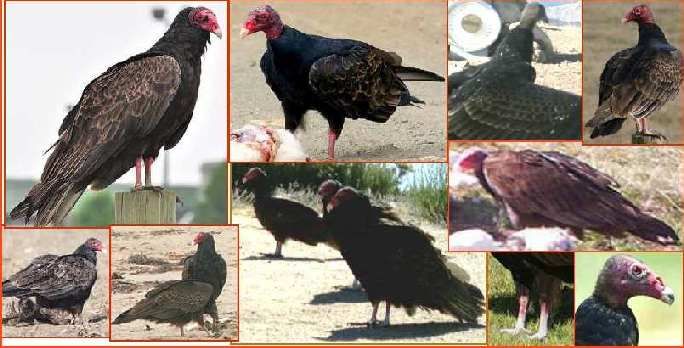
Posted
-
 by
wreness
moderator
by
wreness
moderator
Ravens: Ah, the ravens. You'll see a lot of ravens in the photos here. A lot. A lot. You might even get really sick of ravens. They're usually the first ones to find carcasses and because they have big mouths, they alert everyone else in the area. The upside is you'll see them doing all kinds of funny walks, wandering around like toddlers, puffing up and trying to argue with the other animals and flying in ways that look like origami kites. Ravens are pitch black with heavy, thick beaks. Their feathers are shiny, so a good way to identify them is by the sun reflecting off them. Or look for a bird that's arguing with another animal.
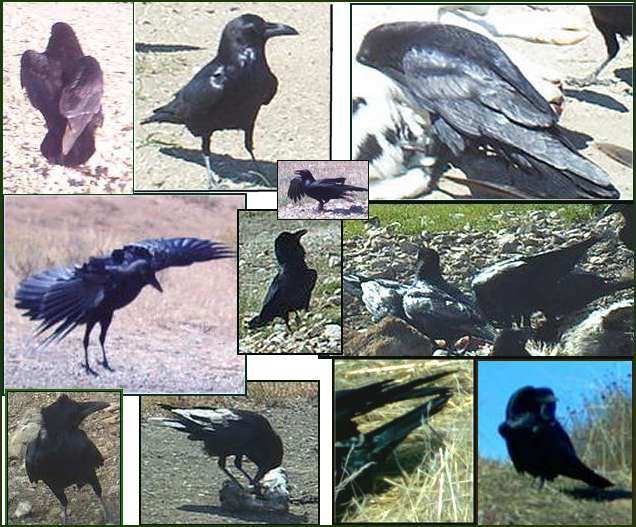
Posted
-
 by
wreness
moderator
by
wreness
moderator
Coyotes: If you see eyeballs in the dark, it's most likely a coyote. They are seen at both day and night. We even have a family of them at one site, including two that each only have 1 eye. They can be seen laying in the grasses at the edge of feeding sites or coming in at the sides, too. They can kill condors and are given wide space by the other animals but will be seen feeding with other animals if there's enough carcass to go around since they're the ones that helpfully rip though the tough hides and crack open bones.
(please see page 2 for size comparison photos)
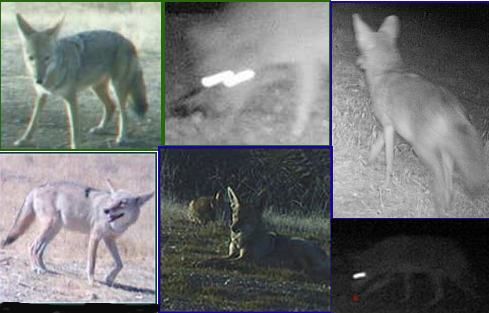
Posted
-
 by
wreness
moderator
by
wreness
moderator
On this page are several photos from this site showing the size or color differences among the animals.
For more info on how to use our classification form and more wonderful photos see our Field Guide For help on colors and numbers, see the Gallery of Wing Tags
Have fun and Carrion!

Posted